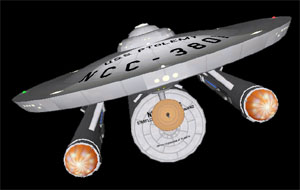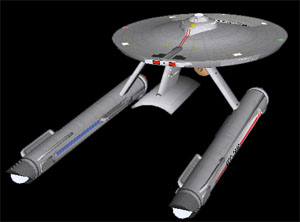
Ptolemy & cargo pod – fore

Ptolemy & cargo pod – fore |
The Ptolemy-class transport/tug is more than merely what its type designation immediately brings to mind. At the time of their introduction they were the fastest, best protected and armed, and most capable and versatile cargo vessels that Starfleet had access to – because they'd been designed to be exactly that by a Starfleet that had badly needed their like for over twenty (20) years. However, with each ship absorbing the same resources to build as a light cruiser, the fledgling Starfleet Transport Command had an uphill struggle to gain appropriations for as many of them as they needed.
Once in service, these ships simply never stopped. So high was the demand for their services that their planned run of one hundred and forty (140) ships was completed in full, and the battle to acquire more began anew. Such was the level of demand for them that even while the rest of the Class I fleet underwent uprating in the 2270s, the Ptolemys simply could not be spared for an eight-to-ten-month full uprating program. Many of the Ptolemy class retained their "Classic" look until the day they were decommissioned.
With the Klingon Empire finally taking proper notice of the United Federaton of Planets, in 2218 they began actively harrassing Federation shipping and colonies close to their mutual border.
The civilian shipping used up until then for Starfleet and offical Federation cargoes were soon replaced by civilian hulls commandeered in the shipyards that Starfleet then completed with their hardware and crews. Civilians were thus removed from the danger zones, and the ships gained a 50% increase in speed and protection over their unmodified brethren.
In the decade that followed it became quite clear that this was insufficient to the task. In the 2230s Starfleet designed and introduced the Sherman and Independence classes of "protected" transports. The Sherman class was used for bulk cargo such as grains and liquids, and Independence class for general cargo of small items like medical supplies and spare parts.
Now capable of warp four and shielded almost to the level of a patrol frigate, these vessels were able to stand off against light raiders and old Klingon patrol craft. While they were a huge step forward, they were still not enough against even small pirates and raiders. They still needed an escort vessel if the expected opposition was heavier than an E-4.
Furthermore the protected transports were all small ships with quite limited cargo space, and the needs of starbases, outposts, and colony worlds were many and varied. To supply everything that was needed by a single base or world required a convoy of at least four freighters and often many more, which would then require an appropriately-sized escort in both numbers and ship types.
After the Four Years War and the havoc wreaked on the Federation Merchant Marine and commercial cargo interests by the Klingon offensive, it was clear that a whole new approach to the problem of "protected" transport in dangerous regions was needed.
With the need for high warp capability to escape small pirate vessels and raiders, strong shields to withstand attack, a large contingent of Security personnel to deter or repulse boarding actions, and perhaps powerful weapons to scare off smaller attackers all already proven from the operations of the last twenty (20) years, the remaining requirements were geared towards what the cargo holds would actually hold.
Starfleet needed these ships to be able to:
Simply put, one cargo hold could not be re-tasked as needed to hold all these varieties of cargo. Multiple holds would be needed, but to have a ship sufficiently large enough for all these holds was never a realistically-considered option.
Starfleet was faced with spiralling costs generated by the apparent need for three or more separate classes of high-speed armed transport ships, or find a different solution.

Hubble – starboard dorsal aft quarter Note the centreline underslung cargo clamp for docking container pods |
That solution came from famed starship designer Franz Joseph. At first toying with the idea of an internally-reconfigurable hold, wherein the hold was an empty volume into which a cargo-specific module could be slotted, he finally came up with something far grander in scope:
An entire logistics system based around massive, externally-docked cargo container hulls.
Scoping out the typical and potential cargo requirements of the colony worlds and bases of the last half-century, Joseph sketched a cylindrical hull with a volume of over 300,000m3 and designed various interiors for them based on the known cargo types. Many more would eventually be designed and built, further exemplifying the versatility and longevity of this system, but Joseph's piece de resistance was the ability to mate several of these container pods sequentially nose-to-tail with a connection that was solidly physical and actively enhanced by magnetics, alignment forcefields, and structural integrity fields. In this manner the only limiting factor in how many pods could be carried was the engine power and warp-field envelope constraints of the tractor vessel.
With the pod system designed and the sheer flexibility in the amount of differing types of cargo that could now be transported in one shipment, the design of the tractor unit or tug started all over again in earnest. All previous designs were scrapped and the concept was boiled down to its base ingredients:
Early on into the design process it was determined that to pull the specified maximum mass of 400,000 MTs plus the mass of the tug itself at the specified cruise speed of warp six, at least two full-sized cruiser-weight nacelles would be needed. The standard cruiser-style tuning-fork arrangement offered the maximum configurability of the warp field envelope between an unencumbered tug up to the tug plus three sequentially attached cargo pods. The ideal placement for these nacelles was determined to be on either side of the first cargo pod.
With the provision for cargo pods to be linked sequentially, the position for the clamp to physically lock-on to the pod was initially considered for the endcap, where the pod would be attached to the tug in a manner identical to that in which pods were attached to each other. However, with the engine nacelles best placed alongside the pod train, the manner in which the engines had to be attached to a main hull also came into play.
Also, the pods were massive and for some types of small cargo direct physical access to internally divided cargo spaces was needed. Thus a vertical-only turbolift system was installed to allow travel between decks within the pod, with corridor access to the rest of the deck. So, a suitable docking point to allow access from the ship to the pod turbolift system also had to be taken into account.
It became apparent that the most practical method would be to connect it directly to the ship's turbolift system – through secure airlocks – through the top or bottom of the cargo pod.
After much simulation of varying configurations, the best solution was determined to be pods and nacelles underslung below a main hull. This gave additional manoeuvrability over a single-plane design, and allowed for warp field envelopes configurable along the same basic curves as a frigate hull. With this in mind, the cargo clamp was suspended between the nacelles on a standard escort-style dorsal neck.
The requirements of the hauling section placed a great many burdens on the design of the main hull. It had to be:
On meeting these myriad requirements Starfleet decided on simplicity of construction, parts commonality, and Fleet interoperability. The full-sized nacelles and escort-style dorsal neck would be attached to a standard Class I starship saucer hull, with an internal layout at least 50% in common with the other ships of the fleet. This would allow for streamlining of construction at yards across the Federation already capable of building escort-class vessels.
This huge main hull would have an escort-style embedded shuttle bay in the forward ventral saucer bulge, with extra shuttle stowage instead devoted to workbee recharge slots. The saucer template for crew quarters was adequate to meet the needs of the transport's projected crew complement, and with the use of a standard hull, a standard cruiser-style engine room could be utilised.
With her role as a fast armed heavy transport for duty in dangerous areas, or carrying military, government, or other high-value cargoes liable to attract raiders, the Ptolemy class was given shielding to the same level as an escort-class ship. This was a massive improvement over previous vessels of even the Sherman and Independence classes of "protected" transports, made possible by the use of a standard saucer. This huge internal volume permitted the installation of more powerful – and thus much larger – shield generators, and a cruiser-level powerplant to allow their use at full strength.
Also, since she was intended from the start to make these journeys unescorted, she was given Starfleet's latest, most powerful phasers to actively defend herself with to drive off any raiders she encountered. Able to put the full power of her weaponry through each emitter, a limited armament of a single twinned forward phaser bank and two single aft-quarter phaser banks was deemed sufficient.
The Ptolemy class was not, however, a warship, despite her power and defences. Her main defence was intended to be her speed and her shielding; not many pirates or raiders could reach her warp six cruising speed – let alone her warp eight emergency speed – being used to picking off the slower merchant vessels that were their usual prey. Her impressive shielding was to protect her until she could escape into warp and outdistance her assailants, but if she was brought to battle she could drop her pods and defend them as well as any frigate could.
However, facing up to pirates and light raiders from belligerent nations was completely different to facing off against a full-sized cruiser. If attacked by a D-6 Raxor-class Klingon battlecruiser, for example, the Ptolemy would stand no chance even if she were armed with photon torpedoes. Obviously, duty in space volatile enough to attract that kind of assailant still required an escort vessel of some type. The Ptolemy class was never intended to stand up to enemy cruisers alone; she was merely to be a hard target for the more opportunistic raiders.